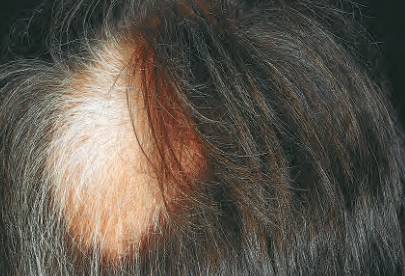
Treatment options of pediatric alopecia areata
Tips for pediatric alopecia areata treatment
- Psychological and emotional well being of the child should be evaluated.
- Educate the parents about the chronic relapsing nature of alopecia areata.
- Reassure the parents that the condition is benign and does not threaten their general health.
- The condition is highly unpredictable in presentation, evolution, and response to treatment.
- Referral to a psychiatrist if psychiatric comorbidities were suspected.
Medical treatment options
Topical treatment options
- Topical corticosteroids
- High potency topical corticosteroids : first line of treatment, safe and effective.
- Side effects include skin atrophy, telangiectasia and folliculitis.
- Evaluate growth after three months of therapy.
- Clobetasol propionate 0.05% cream
- Intralesional steroids
- The use of intralesional steroids in children is limited due the pain.
- Topical minoxidil
- Twice daily.
- Excessive use may lead to systemic absorption (hypotension- palpitation- etc).
- Minoxidil is mostly used as an adjunctive therapy.
- Anthralin (short contact)
- May be used twice a week to once daily.
- Apply 0.5% to 1% anthralin cream to affected scalp once daily; leave on 20 to 30 minutes daily for 2 weeks, and then 45 minutes daily for 2 weeks, up to a maximum of 1 hour daily. Wash hands afterward, and avoid getting anthralin in the eyes.
- Wash hands immediately after application with lukewarm water.
- Remove from scalp with mineral oil; then wash off with soap and water.
- Do not use on eye brows or beard.
- Anthralin may stain the skin, clothing, and hair brown.
- Topical immunotherapy
- Diphenylcyclopropenone (DPCP) concentration of ( 0.0001% and 2%) or Squaric acid dibutylester (SADBE) concentration of ( 0.00001% and 1%) can be used.
- Sensitization with DPCP 2% is followed by weekly application of the lowest concentration that can cause mild irritation.
- The treated areas protected from the sun while the product is on it.
- In most studies treatment was discontinued after 6 months if no response was obtained.
- Temporary occipital and/or cervical lymphadenopathy.
- Doctors should avoid skin contact with the allergen as possible.
- Combination of topical immunotherapy and laser therapy could be suggested for the treatment of extensive AA in children.
- Topical prostaglandins
- Topical bimatoprost 0.03% therapy.
- Topical calcineurin inhibitors
- Topical tacrolimus 0.1%.
- Topical JAK inhibitors
- Tofacitinib 2% ointment.
- Ruxolitinib 1–2% therapy
- Side effects include transient leukopenia and increased liver enzymes in one child.
- Topical sildenafil
- Sildenafil 1% cream applied twice daily for three months.
Systemic treatment options
- Systemic Corticosteroids
- Used for rapidly progressive alopecia areata to slow hair loss.
- Oral, intravenous and intramuscular glucocorticosteroids have been used.
- Pulse oral prednisolone : 5 mg/kg or 300 mg once a month.
- Continuous oral prednisolone (0.5–2 mg/kg/day or 5–10 mg/day)
- Intravenous methylprednisolone pulse therapy (8–30 mg/kg for three days once a month or 500 mg for one day once a month).
- Side effects include headache, abdominal pain, weight gain, steroid acne, muscle pain, behavioral changes, Cushing syndrome, striae, increased ocular pressure, pseudoacanthosis nigricans, hypertrichosis and dysmenorrhea.
- Methotrexate
- 2.5–25 mg/week or 0.2 mg/kg/day.
- Methotrexate is usually used in combination with glucocorticosteroids.
- Side effects include nausea, vomiting, abdominal discomfort, abnormal liver function test results, neutropenia, migraine, leg weakness and tooth sensitivity.
- Cyclosporine
- 100–200 mg/day or 5–7.5 mg/kg/day.
- Used alone or in combination with systemic glucocorticosteroids or PUVA therapy.
- Azathioprine
- 100 mg/day combined with methotrexate or anthralin.
- Hydroxychloroquine
- 50–400 mg daily for 4–24 month.
- Side effects include abdominal pain, headache and viral gastroenteritis.
- Janus kinase inhibitors
- Used for refractory alopecia totalis or alopecia universalis.
- oral tofacitinib 5 mg twice daily.
- Ruxolitinib (80 mg/day).
- Baricitinib (7–11 mg/day).
- Side effects include diarrhoea, upper respiratory tract infection and headaches.
- Leflunomide
- Leflunomide (20 mg/day) and anthralin.
- Mesalazine
- Mesalazine (15–30 mg/day) and topical betamethasone/minoxidil.
- Apremilast
- Apremilast (30 mg/day) and platelet-rich plasma.
- Dupilumab
- Dupilumab 300 mg s.c therapy.
- Ustekinumab
- Ustekinumab therapy 90 mg Intramuscular.
- Compound glycyrrhizin (75 mg/day) with vitamin B2
Physical treatment options
- Cryotherapy
- Superficial cryotherapy in mild Alopecia areata.
- Used in combination with topical steroids.
- Laser therapy
- Excimer laser 308 nm twice weekly.
- Side effects include mild erythema, hyperpigmentation, itching, and mild peeling of the skin.
- Fractional carbon dioxide laser (50–60 mJ/cm2) followed by the topical application of triamcinolone spray.
- Four sessions repeated at an interval of three to four weeks.
- Excimer laser 308 nm twice weekly.
- Phototherapy
- PUVA is not recommended in children.
- PUVA-turban therapy.
Sources :
Therapeutic management in paediatric alopecia areata: A systematic review*
#Alopecia Areata #Alopecia Areata treatment #pediatric alopecia areata #pediatric alopecia areata treatment